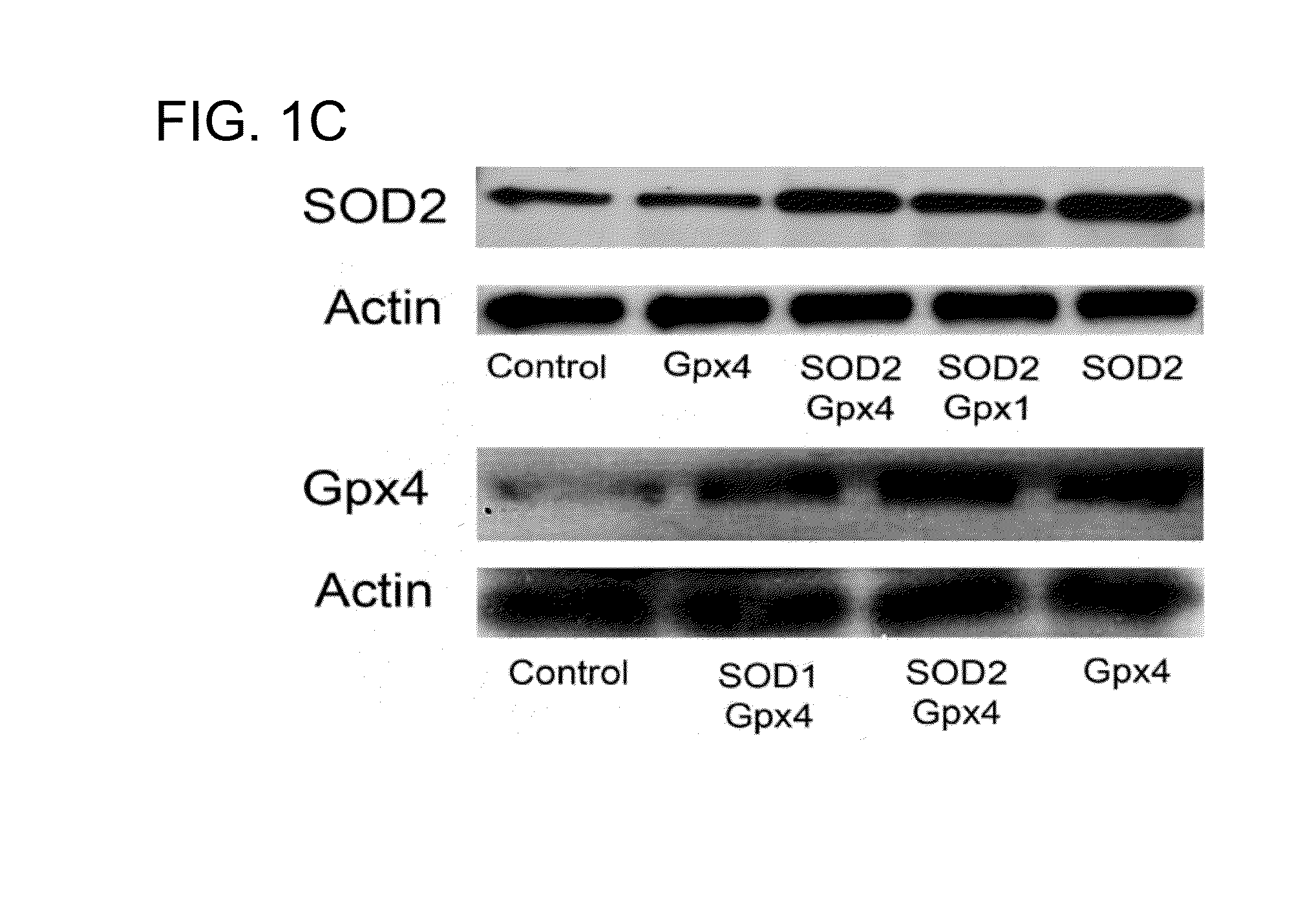Compositions and methods for the treatment of ocular oxidative stress and retinitis pigmentosa
a technology of ocular oxidative stress and retinitis pigmentosa, which is applied in the direction of anti-noxious agents, peptide/protein ingredients, metabolic disorders, etc., can solve the problems of progressive constriction of visual field and eventual blindness, and achieve the effect of preventing the export of protein and redirecting the targeting of protein
- Summary
- Abstract
- Description
- Claims
- Application Information
AI Technical Summary
Benefits of technology
Problems solved by technology
Method used
Image
Examples
example 1
Materials and Methods
Construction of Expression Plasmids
[0171]The pIRES2-EGFP vector (BD Biosciences Clontech, Mountain View, Calif.) was used as the expression vector in RPE cells. The primers for construction were mouse Gpx1: forward: 5′ GCCTCGAGATGTGTGCTGCTCGGCTCTC 3′, reverse: 5′ GCGGATCCTTAGGAGTTGCCAGACTGCT 3′, mouse Gpx4: forward: 5′ GCCTCGAGATGTGTGCATCCCGCGATGA 3′, reverse: 5′ GCGGATCCCTAGAGATAGCACGGCAGGT 3′, mouse Sod1: forward, ATGGCGATGAAAGCGGTGTGC, reverse: 5′ TTACTGCGCAATCCCAATCAC 3′, mouse Sod2, forward: 5′ ATGTTGTGTCGGGCGGCGTGC 3′, reverse; 5′ TCACTTCTTGCAAGCTGTGTA 3′. Fragments of DNA containing full-length murine Gpx1, Gpx4, Sod1 or Sod2 were subcloned into pGEM-T vector (Promega, Madison, Wis.). Each construct was sequenced to confirm the correct sequence and then excised from pGEM-T and ligated into pIRES2-EGFP expression vector. The expression vectors were used in transient transfections in ARPE19 cells (American Type Culture Collection, Manassas, Va.) using Lipof...
example 2
Increased Expression of Gpx1 or Gpx4 in RPE Cells Provides Superior Protection Against Oxidative Stress Compared to Increased Expression of SOD1 or SOD2
[0193]Measurement of the carbonyl content of proteins by ELISA provides a good quantitative assessment of oxidative damage. Compared to control RPE cells, those over-expressing Gpx1 or Gpx4 showed similar protein carbonyl content, but those over-expressing SOD1 or SOD2 showed a significant increase in carbonyl content and reduced viability (FIG. 1A, FIG. 1B, FIG. 1C). This suggests that increased levels of SOD1 or SOD2 enhance constitutive oxidative damage and reduce cell survival in RPE cells. Control RPE cells that were challenged with paraquat, hydrogen peroxide, or hyperoxia had carbonyl levels in the range of 1.2 nM, compared to 0.6 nM in unchallenged cells. In the presence of all 3 types of oxidative stress, RPE cells over-expressing Gpx4 had significantly less carbonyl content than control RPE cells (FIG. 2A, FIG. 2B). Cells o...
example 3
Increased Expression of Gpx4 in Photoreceptors Reduces Paraquat- and Hyperoxia-Induced Oxidative Damage
[0195]The protective effects of Gpx1 and Gpx4 were quite similar in RPE cells; therefore, it was decided to only investigate the effects of Gpx4 in vivo in photoreceptors. TRE / murine Gpx4 transgenic mice were generated and crossed with opsin / rtTA mice to generate opsin / rtTA-TRE / Gpx4 (Tet / opsin / Gpx4) double transgenic mice. When these mice were given drinking water containing 2 mg / ml of doxycycline for two weeks, immunoblots showed increased levels of Gpx4 in the retina (FIG. 3). When 1 μl of 0.75 mM paraquat was injected into the vitreous cavity of littermate control mice or doxycycline-treated Tet / opsin / Gpx4 mice the protein carbonyl content in the retina was increased compared to mice injected with PBS, but the latter had significantly lower levels than the former (FIG. 4A). In contrast, Tet / opsin / Gpx4 mice that were not treated with doxycycline had similar paraquat-induced eleva...
PUM
| Property | Measurement | Unit |
|---|---|---|
| thickness | aaaaa | aaaaa |
| oxidative stress | aaaaa | aaaaa |
| color vision assessment | aaaaa | aaaaa |
Abstract
Description
Claims
Application Information
 Login to View More
Login to View More - R&D
- Intellectual Property
- Life Sciences
- Materials
- Tech Scout
- Unparalleled Data Quality
- Higher Quality Content
- 60% Fewer Hallucinations
Browse by: Latest US Patents, China's latest patents, Technical Efficacy Thesaurus, Application Domain, Technology Topic, Popular Technical Reports.
© 2025 PatSnap. All rights reserved.Legal|Privacy policy|Modern Slavery Act Transparency Statement|Sitemap|About US| Contact US: help@patsnap.com



